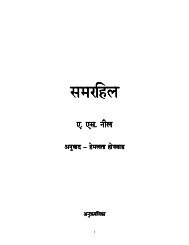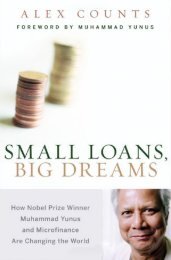Aims in Education [Book Extract] - Vidya Online
Aims in Education [Book Extract] - Vidya Online
Aims in Education [Book Extract] - Vidya Online
You also want an ePaper? Increase the reach of your titles
YUMPU automatically turns print PDFs into web optimized ePapers that Google loves.
DEMOCRACY AND EDUCATION: AN INTRODUCTION TO THE PHILOSOPHY OF EDUCATION<br />
By John Dewey<br />
Chapter Eight: <strong>Aims</strong> <strong>in</strong> <strong>Education</strong><br />
1. The Nature of an Aim. The account of education given <strong>in</strong> our earlier chapters virtually<br />
anticipated the results reached <strong>in</strong> a discussion of the purport of education <strong>in</strong> a democratic<br />
community. For it assumed that the aim of education is to enable <strong>in</strong>dividuals to cont<strong>in</strong>ue their<br />
education -- or that the object and reward of learn<strong>in</strong>g is cont<strong>in</strong>ued capacity for growth. Now this<br />
idea cannot be applied to all the members of a society except where <strong>in</strong>tercourse of man with man is<br />
mutual, and except where there is adequate provision for the reconstruction of social habits and<br />
<strong>in</strong>stitutions by means of wide stimulation aris<strong>in</strong>g from equitably distributed <strong>in</strong>terests. And this<br />
means a democratic society. In our search for aims <strong>in</strong> education, we are not concerned, therefore,<br />
with f<strong>in</strong>d<strong>in</strong>g an end outside of the educative process to which education is subord<strong>in</strong>ate. Our whole<br />
conception forbids. We are rather concerned with the contrast which exists when aims belong<br />
with<strong>in</strong> the process <strong>in</strong> which they operate and when they are set up from without. And the latter<br />
state of affairs must obta<strong>in</strong> when social relationships are not equitably balanced. For <strong>in</strong> that case,<br />
some portions of the whole social group will f<strong>in</strong>d their aims determ<strong>in</strong>ed by an external dictation;<br />
their aims will not arise from the free growth of their own experience, and their nom<strong>in</strong>al aims will<br />
be means to more ulterior ends of others rather than truly their own.<br />
Our first question is to def<strong>in</strong>e the nature of an aim so far as it falls with<strong>in</strong> an activity, <strong>in</strong>stead of<br />
be<strong>in</strong>g furnished from without. We approach the def<strong>in</strong>ition by a contrast of mere results with ends.<br />
Any exhibition of energy has results. The w<strong>in</strong>d blows about the sands of the desert; the position of<br />
the gra<strong>in</strong>s is changed. Here is a result, an effect, but not an end. For there is noth<strong>in</strong>g <strong>in</strong> the<br />
outcome which completes or fulfills what went before it. There is mere spatial redistribution. One<br />
state of affairs is just as good as any other. Consequently there is no basis upon which to select an<br />
earlier state of affairs as a beg<strong>in</strong>n<strong>in</strong>g, a later as an end, and to consider what <strong>in</strong>tervenes as a<br />
process of transformation and realization.<br />
Consider for example the activities of bees <strong>in</strong> contrast with the changes <strong>in</strong> the sands when the w<strong>in</strong>d<br />
blows them about. The results of the bees' actions may be called ends not because they are<br />
designed or consciously <strong>in</strong>tended, but because they are true term<strong>in</strong>ations or completions of what<br />
has preceded. When the bees gather pollen and make wax and build cells, each step prepares the<br />
way for the next. When cells are built, the queen lays eggs <strong>in</strong> them; when eggs are laid, they are<br />
sealed and bees brood them and keep them at a temperature required to hatch them. When they<br />
are hatched, bees feed the young till they can take care of themselves. Now we are so familiar with<br />
such facts, that we are apt to dismiss them on the ground that life and <strong>in</strong>st<strong>in</strong>ct are a k<strong>in</strong>d of<br />
miraculous th<strong>in</strong>g anyway. Thus we fail to note what the essential characteristic of the event is;<br />
namely, the significance of the temporal place and order of each element; the way each prior event<br />
leads <strong>in</strong>to its successor while the successor takes up what is furnished and utilizes it for some other<br />
stage, until we arrive at the end, which, as it were, summarizes and f<strong>in</strong>ishes off the process.<br />
S<strong>in</strong>ce aims relate always to results, the first th<strong>in</strong>g to look to when it is a question of aims, is<br />
whether the work assigned possesses <strong>in</strong>tr<strong>in</strong>sic cont<strong>in</strong>uity. Or is it a mere serial aggregate of acts,<br />
first do<strong>in</strong>g one th<strong>in</strong>g and then another? To talk about an educational aim when approximately each<br />
act of a pupil is dictated by the teacher, when the only order <strong>in</strong> the sequence of his acts is that<br />
which comes from the assignment of lessons and the giv<strong>in</strong>g of directions by another, is to talk<br />
nonsense. It is equally fatal to an aim to permit capricious or discont<strong>in</strong>uous action <strong>in</strong> the name of<br />
spontaneous self-expression. An aim implies an orderly and ordered activity, one <strong>in</strong> which the<br />
order consists <strong>in</strong> the progressive complet<strong>in</strong>g of a process. Given an activity hav<strong>in</strong>g a time span and<br />
cumulative growth with<strong>in</strong> the time succession, an aim means foresight <strong>in</strong> advance of the end or<br />
possible term<strong>in</strong>ation. If bees anticipated the consequences of their activity, if they perceived their<br />
end <strong>in</strong> imag<strong>in</strong>ative foresight, they would have the primary element <strong>in</strong> an aim. Hence it is nonsense<br />
to talk about the aim of education -- or any other undertak<strong>in</strong>g -- where conditions do not permit of<br />
foresight of results, and do not stimulate a person to look ahead to see what the outcome of a<br />
given activity is to be.
In the next place the aim as a foreseen end gives direction to the activity; it is not an idle view of a<br />
mere spectator, but <strong>in</strong>fluences the steps taken to reach the end. The foresight functions <strong>in</strong> three<br />
ways. In the first place, it <strong>in</strong>volves careful observation of the given conditions to see what are the<br />
means available for reach<strong>in</strong>g the end, and to discover the h<strong>in</strong>drances <strong>in</strong> the way. In the second<br />
place, it suggests the proper order or sequence <strong>in</strong> the use of means. It facilitates an economical<br />
selection and arrangement. In the third place, it makes choice of alternatives possible. If we can<br />
predict the outcome of act<strong>in</strong>g this way or that, we can then compare the value of the two courses<br />
of action; we can pass judgment upon their relative desirability. If we know that stagnant water<br />
breeds mosquitoes and that they are likely to carry disease, we can, dislik<strong>in</strong>g that anticipated<br />
result, take steps to avert it. S<strong>in</strong>ce we do not anticipate results as mere <strong>in</strong>tellectual onlookers, but<br />
as persons concerned <strong>in</strong> the outcome, we are partakers <strong>in</strong> the process which produces the result.<br />
We <strong>in</strong>tervene to br<strong>in</strong>g about this result or that.<br />
Of course these three po<strong>in</strong>ts are closely connected with one another. We can def<strong>in</strong>itely foresee<br />
results only as we make careful scrut<strong>in</strong>y of present conditions, and the importance of the outcome<br />
supplies the motive for observations. The more adequate our observations, the more varied is the<br />
scene of conditions and obstructions that presents itself, and the more numerous are the<br />
alternatives between which choice may be made. In turn, the more numerous the recognized<br />
possibilities of the situation, or alternatives of action, the more mean<strong>in</strong>g does the chosen activity<br />
possess, and the more flexibly controllable is it. Where only a s<strong>in</strong>gle outcome has been thought of,<br />
the m<strong>in</strong>d has noth<strong>in</strong>g else to th<strong>in</strong>k of; the mean<strong>in</strong>g attach<strong>in</strong>g to the act is limited. One only steams<br />
ahead toward the mark. Sometimes such a narrow course may be effective. But if unexpected<br />
difficulties offer themselves, one has not as many resources at command as if he had chosen the<br />
same l<strong>in</strong>e of action after a broader survey of the possibilities of the field. He cannot make needed<br />
readjustments readily.<br />
The net conclusion is that act<strong>in</strong>g with an aim is all one with act<strong>in</strong>g <strong>in</strong>telligently. To foresee a<br />
term<strong>in</strong>us of an act is to have a basis upon which to observe, to select, and to order objects and our<br />
own capacities. To do these th<strong>in</strong>gs means to have a m<strong>in</strong>d -- for m<strong>in</strong>d is precisely <strong>in</strong>tentional<br />
purposeful activity controlled by perception of facts and their relationships to one another. To have<br />
a m<strong>in</strong>d to do a th<strong>in</strong>g is to foresee a future possibility; it is to have a plan for its accomplishment; it<br />
is to note the means which make the plan capable of execution and the obstructions <strong>in</strong> the way, --<br />
or, if it is really a m<strong>in</strong>d to do the th<strong>in</strong>g and not a vague aspiration -- it is to have a plan which<br />
takes account of resources and difficulties. M<strong>in</strong>d is capacity to refer present conditions to future<br />
results, and future consequences to present conditions. And these traits are just what is meant by<br />
hav<strong>in</strong>g an aim or a purpose. A man is stupid or bl<strong>in</strong>d or un<strong>in</strong>telligent -- lack<strong>in</strong>g <strong>in</strong> m<strong>in</strong>d -- just <strong>in</strong><br />
the degree <strong>in</strong> which <strong>in</strong> any activity he does not know what he is about, namely, the probable<br />
consequences of his acts. A man is imperfectly <strong>in</strong>telligent when he contents himself with looser<br />
guesses about the outcome than is needful, just tak<strong>in</strong>g a chance with his luck, or when he forms<br />
plans apart from study of the actual conditions, <strong>in</strong>clud<strong>in</strong>g his own capacities. Such relative absence<br />
of m<strong>in</strong>d means to make our feel<strong>in</strong>gs the measure of what is to happen. To be <strong>in</strong>telligent we must<br />
"stop, look, listen" <strong>in</strong> mak<strong>in</strong>g the plan of an activity.<br />
To identify act<strong>in</strong>g with an aim and <strong>in</strong>telligent activity is enough to show its value -- its function <strong>in</strong><br />
experience. We are only too given to mak<strong>in</strong>g an entity out of the abstract noun "consciousness."<br />
We forget that it comes from the adjective "conscious." To be conscious is to be aware of what we<br />
are about; conscious signifies the deliberate, observant, plann<strong>in</strong>g traits of activity. Consciousness is<br />
noth<strong>in</strong>g which we have which gazes idly on the scene around one or which has impressions made<br />
upon it by physical th<strong>in</strong>gs; it is a name for the purposeful quality of an activity, for the fact that it<br />
is directed by an aim. Put the other way about, to have an aim is to act with mean<strong>in</strong>g, not like an<br />
automatic mach<strong>in</strong>e; it is to mean to do someth<strong>in</strong>g and to perceive the mean<strong>in</strong>g of th<strong>in</strong>gs <strong>in</strong> the<br />
light of that <strong>in</strong>tent.<br />
2. The Criteria of Good <strong>Aims</strong>. We may apply the results of our discussion to a consideration of<br />
the criteria <strong>in</strong>volved <strong>in</strong> a correct establish<strong>in</strong>g of aims. ( 1) The aim set up must be an outgrowth of<br />
exist<strong>in</strong>g conditions. It must be based upon a consideration of what is already go<strong>in</strong>g on; upon the<br />
resources and difficulties of the situation. Theories about the proper end of our activities --
educational and moral theories -- often violate this pr<strong>in</strong>ciple. They assume ends ly<strong>in</strong>g outside our<br />
activities; ends foreign to the concrete makeup of the situation; ends which issue from some<br />
outside source. Then the problem is to br<strong>in</strong>g our activities to bear upon the realization of these<br />
externally supplied ends. They are someth<strong>in</strong>g for which we ought to act. In any case such "aims"<br />
limit <strong>in</strong>telligence; they are not the expression of m<strong>in</strong>d <strong>in</strong> foresight, observation, and choice of the<br />
better among alternative possibilities. They limit <strong>in</strong>telligence because, given ready-made, they<br />
must be imposed by some authority external to <strong>in</strong>telligence, leav<strong>in</strong>g to the latter noth<strong>in</strong>g but a<br />
mechanical choice of means.<br />
( 2 ) We have spoken as if aims could be completely formed prior to the attempt to realize them.<br />
This impression must now be qualified. The aim as it first emerges is a mere tentative sketch. The<br />
act of striv<strong>in</strong>g to realize it tests its worth. If it suffices to direct activity successfully, noth<strong>in</strong>g more<br />
is required, s<strong>in</strong>ce its whole function is to set a mark <strong>in</strong> advance; and at times a mere h<strong>in</strong>t may<br />
suffice. But usually -- at least <strong>in</strong> complicated situations -- act<strong>in</strong>g upon it br<strong>in</strong>gs to light conditions<br />
which had been overlooked. This calls for revision of the orig<strong>in</strong>al aim; it has to be added to and<br />
subtracted from. An aim must, then, be flexible; it must be capable of alteration to meet<br />
circumstances. An end established externally to the process of action is always rigid. Be<strong>in</strong>g <strong>in</strong>serted<br />
or imposed from without, it is not supposed to have a work<strong>in</strong>g relationship to the concrete<br />
conditions of the situation. What happens <strong>in</strong> the course of action neither confirms, refutes, nor<br />
alters it. Such an end can only be <strong>in</strong>sisted upon. The failure that results from its lack of adaptation<br />
is attributed simply to the perverseness of conditions, not to the fact that the end is not reasonable<br />
under the circumstances. The value of a legitimate aim, on the contrary, lies <strong>in</strong> the fact that we<br />
can use it to change conditions. It is a method for deal<strong>in</strong>g with conditions so as to effect desirable<br />
alterations <strong>in</strong> them. A farmer who should passively accept th<strong>in</strong>gs just as he f<strong>in</strong>ds them would make<br />
as great a mistake as he who framed his plans <strong>in</strong> complete disregard of what soil, climate, etc.,<br />
permit. One of the evils of an abstract or remote external aim <strong>in</strong> education is that its very<br />
<strong>in</strong>applicability <strong>in</strong> practice is likely to react <strong>in</strong>to a haphazard snatch<strong>in</strong>g at immediate conditions. A<br />
good aim surveys the present state of experience of pupils, and form<strong>in</strong>g a tentative plan of<br />
treatment, keeps the plan constantly <strong>in</strong> view and yet modifies it as conditions develop. The aim, <strong>in</strong><br />
short, is experimental, and hence constantly grow<strong>in</strong>g as it is tested <strong>in</strong> action.<br />
(3) The aim must always represent a free<strong>in</strong>g of activities. The term end <strong>in</strong> view is suggestive, for it<br />
puts before the m<strong>in</strong>d the term<strong>in</strong>ation or conclusion of some process. The only way <strong>in</strong> which we can<br />
def<strong>in</strong>e an activity is by putt<strong>in</strong>g before ourselves the objects <strong>in</strong> which it term<strong>in</strong>ates -- as one's aim <strong>in</strong><br />
shoot<strong>in</strong>g is the target. But we must remember that the object is only a mark or sign by which the<br />
m<strong>in</strong>d specifies the activity one desires to carry out. Strictly speak<strong>in</strong>g, not the target but hitt<strong>in</strong>g the<br />
target is the end <strong>in</strong> view; one takes aim by means of the target, but also by the sight on the gun.<br />
The different objects which are thought of are means of direct<strong>in</strong>g the activity. Thus one aims at,<br />
say, a rabbit; what he wants is to shoot straight: a certa<strong>in</strong> k<strong>in</strong>d of activity. Or, if it is the rabbit he<br />
wants, it is not rabbit apart from his activity, but as a factor <strong>in</strong> activity; he wants to eat the rabbit,<br />
or to show it as evidence of his marksmanship -- he wants to do someth<strong>in</strong>g with it. The do<strong>in</strong>g with<br />
the th<strong>in</strong>g, not the th<strong>in</strong>g <strong>in</strong> isolation, is his end. The object is but a phase of the active end, --<br />
cont<strong>in</strong>u<strong>in</strong>g the activity successfully. This is what is meant by the phrase, used above, "free<strong>in</strong>g<br />
activity."<br />
In contrast with fulfill<strong>in</strong>g some process <strong>in</strong> order that activity may go on, stands the static character<br />
of an end which is imposed from without the activity. It is always conceived of as fixed; it is<br />
someth<strong>in</strong>g to be atta<strong>in</strong>ed and possessed. When one has such a notion, activity is a mere<br />
unavoidable means to someth<strong>in</strong>g else; it is not significant or important on its own account. As<br />
compared with the end it is but a necessary evil; someth<strong>in</strong>g which must be gone through before<br />
one can reach the object which is alone worth while. In other words, the external idea of the aim<br />
leads to a separation of means from end, while an end which grows up with<strong>in</strong> an activity as plan for<br />
its direction is always both ends and means, the dist<strong>in</strong>ction be<strong>in</strong>g only one of convenience. Every<br />
means is a temporary end until we have atta<strong>in</strong>ed it. Every end becomes a means of carry<strong>in</strong>g<br />
activity further as soon as it is achieved. We call it end when it marks off the future direction of the<br />
activity <strong>in</strong> which we are engaged; means when it marks off the present direction. Every divorce of<br />
end from means dim<strong>in</strong>ishes by that much the significance of the activity and tends to reduce it to a<br />
drudgery from which one would escape if he could. A farmer has to use plants and animals to carry<br />
on his farm<strong>in</strong>g activities. It certa<strong>in</strong>ly makes a great difference to his life whether he is fond of<br />
them, or whether he regards them merely as means which he has to employ to get someth<strong>in</strong>g else
<strong>in</strong> which alone he is <strong>in</strong>terested. In the former case, his entire course of activity is significant; each<br />
phase of it has its own value. He has the experience of realiz<strong>in</strong>g his end at every stage; the<br />
postponed aim, or end <strong>in</strong> view, be<strong>in</strong>g merely a sight ahead by which to keep his activity go<strong>in</strong>g fully<br />
and freely. For if he does not look ahead, he is more likely to f<strong>in</strong>d himself blocked. The aim is as<br />
def<strong>in</strong>itely a means of action as is any other portion of an activity.<br />
3. Applications <strong>in</strong> <strong>Education</strong>. There is noth<strong>in</strong>g peculiar about educational aims. They are just like<br />
aims <strong>in</strong> any directed occupation. The educator, like the farmer, has certa<strong>in</strong> th<strong>in</strong>gs to do, certa<strong>in</strong><br />
resources with which to do, and certa<strong>in</strong> obstacles with which to contend. The conditions with which<br />
the farmer deals, whether as obstacles or resources, have their own structure and operation<br />
<strong>in</strong>dependently of any purpose of his. Seeds sprout, ra<strong>in</strong> falls, the sun sh<strong>in</strong>es, <strong>in</strong>sects devour, blight<br />
comes, the seasons change. His aim is simply to utilize these various conditions; to make his<br />
activities and their energies work together, <strong>in</strong>stead of aga<strong>in</strong>st one another. It would be absurd if<br />
the farmer set up a purpose of farm<strong>in</strong>g, without any reference to these conditions of soil, climate,<br />
characteristic of plant growth, etc. His purpose is simply a foresight of the consequences of his<br />
energies connected with those of the th<strong>in</strong>gs about him, a foresight used to direct his movements<br />
from day to day. Foresight of possible consequences leads to more careful and extensive<br />
observation of the nature and performances of the th<strong>in</strong>gs he had to do with, and to lay<strong>in</strong>g out a<br />
plan -- that is, of a certa<strong>in</strong> order <strong>in</strong> the acts to be performed.<br />
It is the same with the educator, whether parent or teacher. It is as absurd for the latter to set up<br />
his "own" aims as the proper objects of the growth of the children as it would be for the farmer to<br />
set up an ideal of farm<strong>in</strong>g irrespective of conditions. <strong>Aims</strong> mean acceptance of responsibility for the<br />
observations, anticipations, and arrangements required <strong>in</strong> carry<strong>in</strong>g on a function -- whether<br />
farm<strong>in</strong>g or educat<strong>in</strong>g. Any aim is of value so far as it assists observation, choice, and plann<strong>in</strong>g <strong>in</strong><br />
carry<strong>in</strong>g on activity from moment to moment and hour to hour; if it gets <strong>in</strong> the way of the<br />
<strong>in</strong>dividual's own common sense ( as it will surely do if imposed from without or accepted on<br />
authority ) it does harm.<br />
And it is well to rem<strong>in</strong>d ourselves that education as such has no aims. Only persons, parents, and<br />
teachers, etc., have aims, not an abstract idea like education. And consequently their purposes are<br />
<strong>in</strong>def<strong>in</strong>itely varied, differ<strong>in</strong>g with different children, chang<strong>in</strong>g as children grow and with the growth<br />
of experience on the part of the one who teaches. Even the most valid aims which can be put <strong>in</strong><br />
words will, as words, do more harm than good unless one recognizes that they are not aims, but<br />
rather suggestions to educators as to how to observe, how to look ahead, and how to choose <strong>in</strong><br />
liberat<strong>in</strong>g and direct<strong>in</strong>g the energies of the concrete situations <strong>in</strong> which they f<strong>in</strong>d themselves. As a<br />
recent writer has said: "To lead this boy to read Scott's novels <strong>in</strong>stead of old Sleuth's stories; to<br />
teach this girl to sew; to root out the habit of bully<strong>in</strong>g from John's make-up; to prepare this class<br />
to study medic<strong>in</strong>e, -- these are samples of the millions of aims we have actually before us <strong>in</strong> the<br />
concrete work of education."<br />
Bear<strong>in</strong>g these qualifications <strong>in</strong> m<strong>in</strong>d, we shall proceed to state some of the characteristics found <strong>in</strong><br />
all good educational aims. (1) An educational aim must be founded upon the <strong>in</strong>tr<strong>in</strong>sic activities and<br />
needs (<strong>in</strong>clud<strong>in</strong>g orig<strong>in</strong>al <strong>in</strong>st<strong>in</strong>cts and acquired habits) of the given <strong>in</strong>dividual to be educated. The<br />
tendency of such an aim as preparation is, as we have seen, to omit exist<strong>in</strong>g powers, and f<strong>in</strong>d the<br />
aim <strong>in</strong> some remote accomplishment or responsibility. In general, there is a disposition to take<br />
considerations which are dear to the hearts of adults and set them up as ends irrespective of the<br />
capacities of those educated. There is also an <strong>in</strong>cl<strong>in</strong>ation to propound aims which are so uniform as<br />
to neglect the specific powers and requirements of an <strong>in</strong>dividual, forgett<strong>in</strong>g that all learn<strong>in</strong>g is<br />
someth<strong>in</strong>g which happens to an <strong>in</strong>dividual at a given time and place. The larger range of perception<br />
of the adult is of great value <strong>in</strong> observ<strong>in</strong>g the abilities and weaknesses of the young, <strong>in</strong> decid<strong>in</strong>g<br />
what they may amount to. Thus the artistic capacities of the adult exhibit what certa<strong>in</strong> tendencies<br />
of the child are capable of; if we did not have the adult achievements we should be without<br />
assurance as to the significance of the draw<strong>in</strong>g, reproduc<strong>in</strong>g, model<strong>in</strong>g, color<strong>in</strong>g activities of<br />
childhood. So if it were not for adult language, we should not be able to see the import of the<br />
babbl<strong>in</strong>g impulses of <strong>in</strong>fancy. But it is one th<strong>in</strong>g to use adult accomplishments as a context <strong>in</strong> which<br />
to place and survey the do<strong>in</strong>gs of childhood and youth; it is quite another to set them up as a fixed<br />
aim without regard to the concrete activities of those educated.
(2) An aim must be capable of translation <strong>in</strong>to a method of cooperat<strong>in</strong>g with the activities of those<br />
undergo<strong>in</strong>g <strong>in</strong>struction. It must suggest the k<strong>in</strong>d of environment needed to liberate and to organize<br />
their capacities. Unless it lends itself to the construction of specific procedures, and unless these<br />
procedures test, correct, and amplify the aim, the latter is worthless. Instead of help<strong>in</strong>g the specific<br />
task of teach<strong>in</strong>g, it prevents the use of ord<strong>in</strong>ary judgment <strong>in</strong> observ<strong>in</strong>g and siz<strong>in</strong>g up the situation.<br />
It operates to exclude recognition of everyth<strong>in</strong>g except what squares up with the fixed end <strong>in</strong> view.<br />
Every rigid aim just because it is rigidly given seems to render it unnecessary to give careful<br />
attention to concrete conditions. S<strong>in</strong>ce it must apply anyhow, what is the use of not<strong>in</strong>g details<br />
which do not count?<br />
The vice of externally imposed ends has deep roots. Teachers receive them from superior<br />
authorities; these authorities accept them from what is current <strong>in</strong> the community. The teachers<br />
impose them upon children. As a first consequence, the <strong>in</strong>telligence of the teacher is not free; it is<br />
conf<strong>in</strong>ed to receiv<strong>in</strong>g the aims laid down from above. Too rarely is the <strong>in</strong>dividual teacher so free<br />
from the dictation of authoritative supervisor, textbook on methods, prescribed course of study,<br />
etc., that he can let his m<strong>in</strong>d come to close quarters with the pupil's m<strong>in</strong>d and the subject matter.<br />
This distrust of the teacher's experience is then reflected <strong>in</strong> lack of confidence <strong>in</strong> the responses of<br />
pupils. The latter receive their aims through a double or treble external imposition, and are<br />
constantly confused by the conflict between the aims which are natural to their own experience at<br />
the time and those <strong>in</strong> which they are taught to acquiesce. Until the democratic criterion of the<br />
<strong>in</strong>tr<strong>in</strong>sic significance of every grow<strong>in</strong>g experience is recognized, we shall be <strong>in</strong>tellectually confused<br />
by the demand for adaptation to external aims.<br />
(3) Educators have to be on their guard aga<strong>in</strong>st ends that are alleged to be general and ultimate.<br />
Every activity, however specific, is, of course, general <strong>in</strong> its ramified connections, for it leads out<br />
<strong>in</strong>def<strong>in</strong>itely <strong>in</strong>to other th<strong>in</strong>gs. So far as a general idea makes us more alive to these connections, it<br />
cannot be too general. But "general" also means "abstract," or detached from all specific context.<br />
And such abstractness means remoteness, and throws us back, once more, upon teach<strong>in</strong>g and<br />
learn<strong>in</strong>g as mere means of gett<strong>in</strong>g ready for an end disconnected from the means. That education<br />
is literally and all the time its own reward means that no alleged study or discipl<strong>in</strong>e is educative<br />
unless it is worth while <strong>in</strong> its own immediate hav<strong>in</strong>g. A truly general aim broadens the outlook; it<br />
stimulates one to take more consequences (connections) <strong>in</strong>to account. This means a wider and<br />
more flexible observation of means. The more <strong>in</strong>teract<strong>in</strong>g forces, for example, the farmer takes<br />
<strong>in</strong>to account, the more varied will be his immediate resources. He will see a greater number of<br />
possible start<strong>in</strong>g places, and a greater number of ways of gett<strong>in</strong>g at what he wants to do. The fuller<br />
one's conception of possible future achievements, the less his present activity is tied down to a<br />
small number of alternatives. If one knew enough, one could start almost anywhere and susta<strong>in</strong> his<br />
activities cont<strong>in</strong>uously and fruitfully.<br />
Understand<strong>in</strong>g then the term general or comprehensive aim simply <strong>in</strong> the sense of a broad survey<br />
of the field of present activities, we shall take up some of the larger ends which have currency <strong>in</strong><br />
the educational theories of the day, and consider what light they throw upon the immediate<br />
concrete and diversified aims which are always the educator's real concern. We premise (as <strong>in</strong>deed<br />
immediately follows from what has been said) that there is no need of mak<strong>in</strong>g a choice among<br />
them or regard<strong>in</strong>g them as competitors. When we come to act <strong>in</strong> a tangible way we have to select<br />
or choose a particular act at a particular time, but any number of comprehensive ends may exist<br />
without competition, s<strong>in</strong>ce they mean simply different ways of look<strong>in</strong>g at the same scene. One<br />
cannot climb a number of different mounta<strong>in</strong>s simultaneously, but the views had when different<br />
mounta<strong>in</strong>s are ascended supplement one another: they do not set up <strong>in</strong>compatible, compet<strong>in</strong>g<br />
worlds. Or, putt<strong>in</strong>g the matter <strong>in</strong> a slightly different way, one statement of an end may suggest<br />
certa<strong>in</strong> questions and observations, and another statement another set of questions, call<strong>in</strong>g for<br />
other observations. Then the more general ends we have, the better. One statement will<br />
emphasize what another slurs over. What a plurality of hypotheses does for the scientific<br />
<strong>in</strong>vestigator, a plurality of stated aims may do for the <strong>in</strong>structor.<br />
Summary. An aim denotes the result of any natural process brought to consciousness and made a<br />
factor <strong>in</strong> determ<strong>in</strong><strong>in</strong>g present observation and choice of ways of act<strong>in</strong>g. It signifies that an activity<br />
has become <strong>in</strong>telligent. Specifically it means foresight of the alternative consequences attendant<br />
upon act<strong>in</strong>g <strong>in</strong> a given situation <strong>in</strong> different ways, and the use of what is anticipated to direct<br />
observation and experiment. A true aim is thus opposed at every po<strong>in</strong>t to an aim which is imposed
upon a process of action from without. The latter is fixed and rigid; it is not a stimulus to<br />
<strong>in</strong>telligence <strong>in</strong> the given situation, but is an externally dictated order to do such and such th<strong>in</strong>gs.<br />
Instead of connect<strong>in</strong>g directly with present activities, it is remote, divorced from the means by<br />
which it is to be reached. Instead of suggest<strong>in</strong>g a freer and better balanced activity, it is a limit set<br />
to activity. In education, the currency of these externally imposed aims is responsible for the<br />
emphasis put upon the notion of preparation for a remote future and for render<strong>in</strong>g the work of<br />
both teacher and pupil mechanical and slavish.<br />
Compiled by <strong>Vidya</strong> Onl<strong>in</strong>e


![Aims in Education [Book Extract] - Vidya Online](https://img.yumpu.com/29615477/1/500x640/aims-in-education-book-extract-vidya-online.jpg)

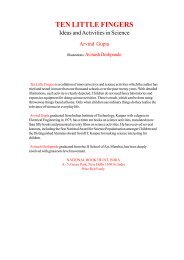
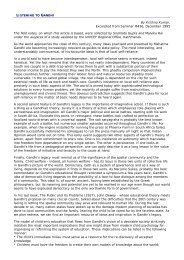
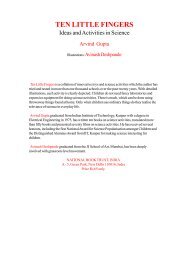



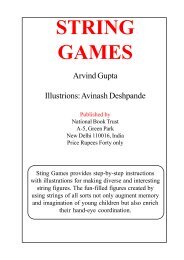

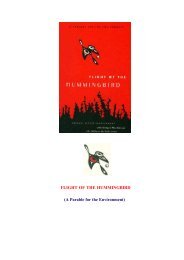
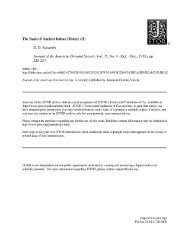
![tq,a] diM+s vkSj vk/qfud ekuo - Vidya Online](https://img.yumpu.com/31264147/1/190x245/tqa-dim-s-vksj-vk-qfud-ekuo-vidya-online.jpg?quality=85)

